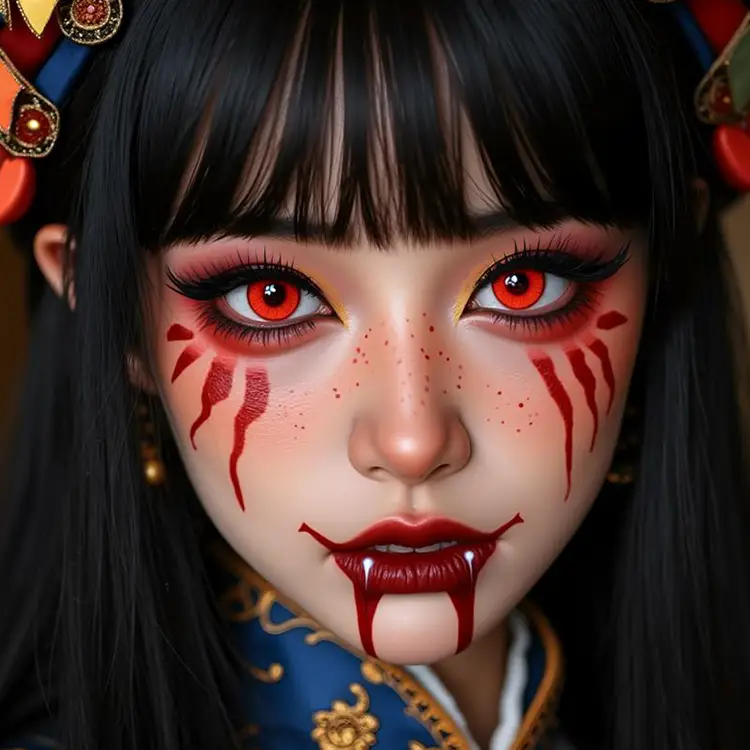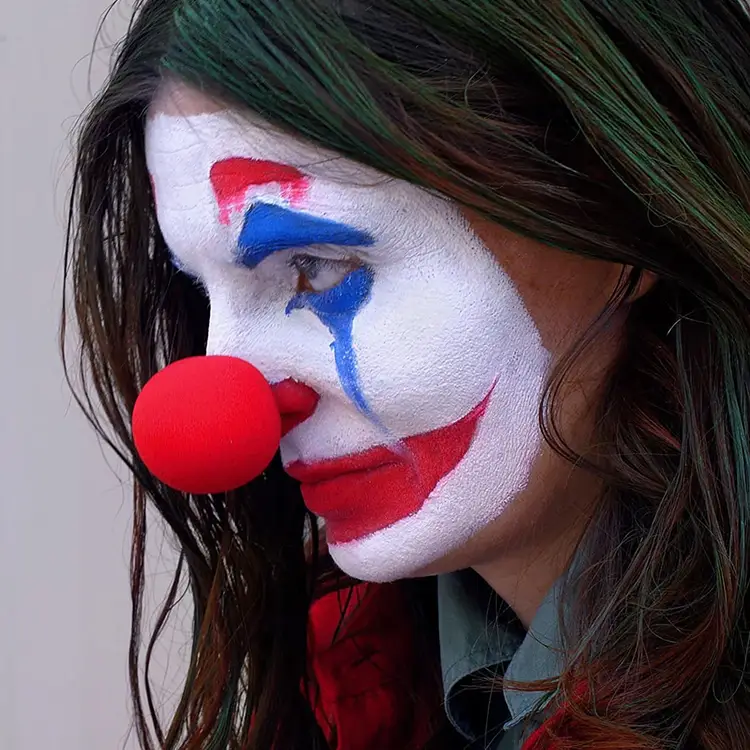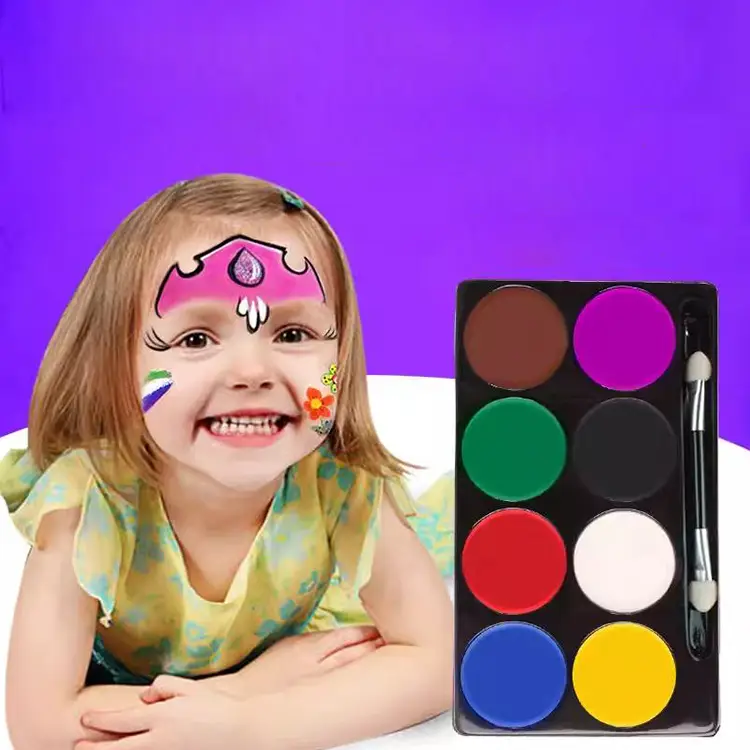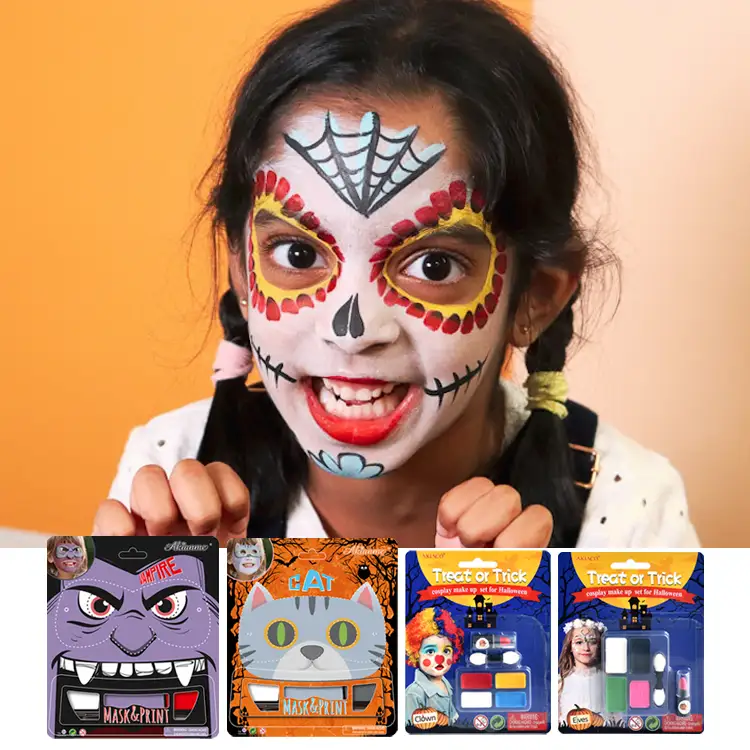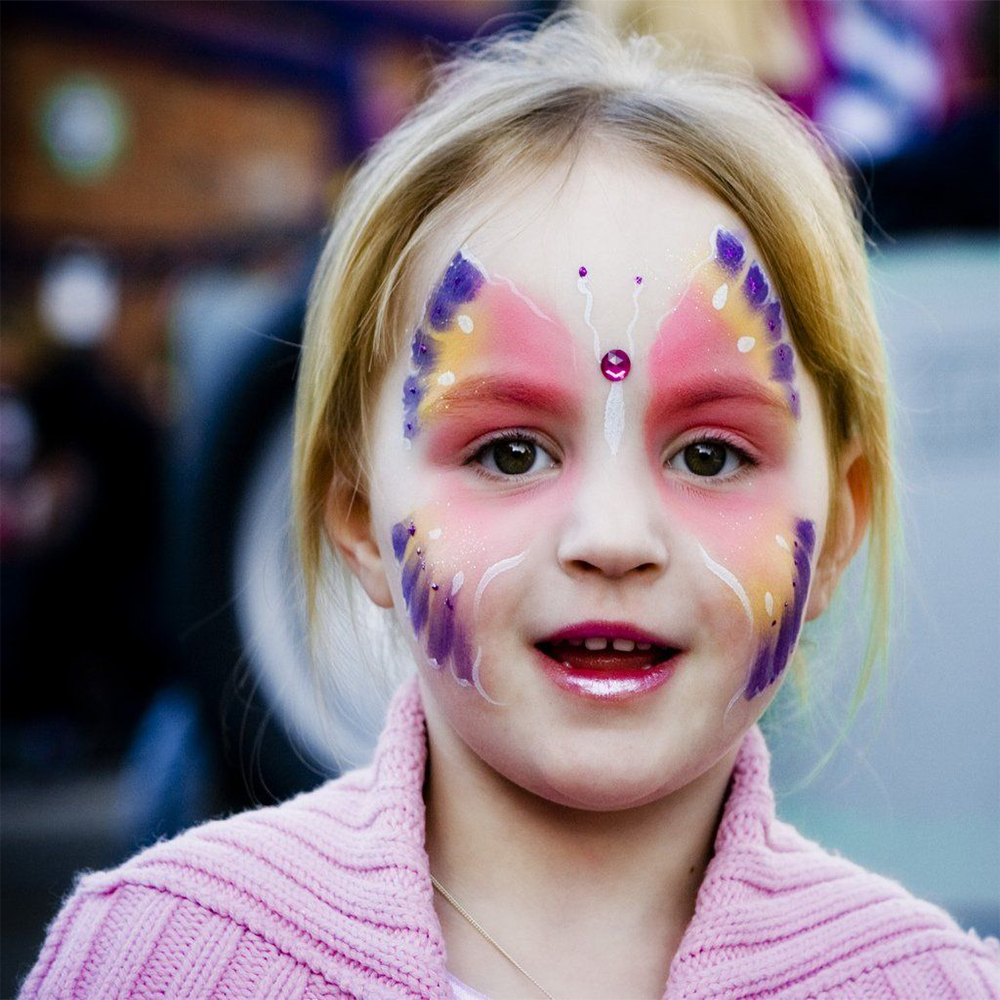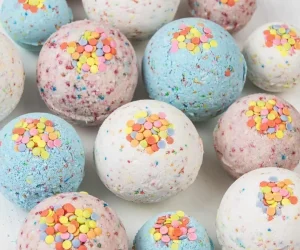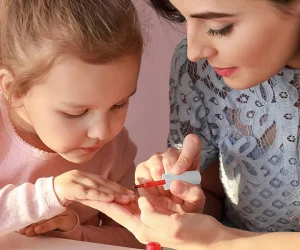Where Did Face Paint Originate? Tracing the Colorful History
Table of Contents
Face paint has been part of human history for tens of thousands of years. It wasn’t created for beauty alone—it served as a tool of identity, expression, and survival. Across continents and eras, people used natural pigments from earth and plants to mark faces with meaning that went beyond color. From caves to ancient villages, the traces of painted skin tell stories of belief, ritual, and belonging.
The Early Purpose of Face Painting in Human History
Long before modern makeup or festivals, early humans used face paint as part of daily and spiritual life. Evidence from Paleolithic sites suggests the use of red ochre—a clay rich in iron oxide—around 30,000 years ago (Watts, 2009). It may have protected skin from sun and insects or carried symbolic meaning tied to life and death.
Anthropologists believe early face painting wasn’t only about decoration but also about identity. Hunters may have used dark pigments like charcoal to blend into the environment. In other cases, bright markings were used to show rank, courage, or connection to a tribe. The face became both a canvas and a signal to the world—a reflection of who someone was within their group.
Face Paint as Communication, Protection, and Identity
In many early cultures, face paint acted as a silent language. Different colors and designs carried messages understood only by members of a tribe or community. Red might represent strength, white could symbolize peace, and black often signified power or preparation for conflict. This form of visual communication helped early societies maintain order and unity.
Face paint also served a protective purpose. Many natural pigments contained minerals that helped block sunlight or repel insects. In hotter climates, people used clay and ash to cool the skin and prevent burns. Even today, this tradition survives in some regions, blending ancient science with cultural meaning.
Archaeological and Anthropological Evidence of Ancient Face Paint
Archaeologists have found small grinding stones with pigment residues in caves across Africa and Australia. These artifacts, often dating back over 40,000 years, suggest the early preparation of colored pastes for skin decoration. Some researchers link this practice to early symbolic thought—the same kind that gave rise to art and language.
Anthropological studies of modern Indigenous groups offer more clues. The San people of Southern Africa and the Australian Aboriginals still use natural pigments for rituals, storytelling, and social ceremonies. Their traditions echo the earliest uses of face paint, showing how this simple act of coloring the skin connects generations across time.
Face painting, then, is not just an ancient custom—it’s one of humanity’s first forms of art and self-expression, linking survival, spirit, and creativity in one enduring tradition.
Face Paint in Ancient Civilizations
As societies grew more complex, face paint became more than a survival tool—it evolved into an art form tied to class, culture, and belief. Across continents, ancient civilizations developed unique pigments, symbols, and styles that revealed how they viewed beauty, power, and the divine. From Egyptian tombs to tribal gatherings, painted faces told stories words could not.
Egypt — Symbolism, Status, and Ritual Beauty
In ancient Egypt, face paint was part of daily life and ritual practice. Both men and women used pigments not only for beauty but also for protection and symbolism. The famous green malachite and black kohl around the eyes were more than decoration—they were believed to ward off evil spirits and shield against the desert sun (Lucas & Harris, Ancient Egyptian Materials and Industries, 1962).
Egyptians used color to reflect social status and connection to the gods. Blue and gold symbolized divinity, while red ochre was often used on lips and cheeks to express vitality. High-ranking officials and priests painted their faces during ceremonies to represent purity and transformation. Face paint, in this sense, bridged the human and the divine.
Indigenous Tribes — Spiritual and Ceremonial Uses
Among Indigenous peoples across the Americas, Australia, and Africa, face paint carried deep spiritual meaning. Each pattern, line, or color told a story—of ancestry, courage, or faith. For example, many Native American tribes used red paint during war ceremonies as a mark of life and power, while white could signify peace or mourning.
These traditions often involved natural pigments from clay, charcoal, berries, and minerals. Paints were applied during dances, healing rituals, and seasonal festivals. The act of painting was sacred—it connected individuals to nature, ancestors, and spiritual forces. In some tribes, elders passed down these symbols through generations, preserving cultural memory through color and design.
Asian and African Cultures — Colors with Cultural Meaning
In Asia, face paint often appeared in theater and ceremony. Ancient Chinese opera makeup, for instance, used bold red, black, and white tones to symbolize character traits—red for loyalty, black for strength, and white for deceit. Similarly, in Japan, the white face of Kabuki actors represented elegance and otherworldly beauty. These traditions turned face paint into a language of performance and emotion.
Across Africa, face painting held both artistic and spiritual power. The Maasai used red ochre to express beauty and pride, while the Yoruba used white clay during sacred rituals. In many African cultures, designs changed with age, season, or ceremony, showing that face paint was both a cultural code and a living form of identity.
Whether in royal courts or open plains, these ancient practices reveal a shared truth—face paint has always been a way for people to define who they are, what they believe, and where they belong.
The Role of Natural Pigments in Early Face Paint
Before modern chemistry and synthetic dyes, people turned to the earth for color. Early face paint came directly from nature—minerals, clays, ashes, and plants mixed into pastes that transformed bare skin into a message of power, beauty, or faith. These natural pigments formed the foundation of human artistry, combining science and spirit long before laboratories existed.
Minerals, Clays, and Charcoal as Ancient Pigments
Archaeological findings reveal that red ochre, yellow clay, and charcoal were among the first materials used for face painting. Red ochre, rich in iron oxide, was favored for its vivid hue and durability. Charcoal provided deep black tones, while white clays made from kaolin or chalk brightened designs. These minerals were crushed into fine powders and often mixed with animal fat or plant oil for easier application.
In many regions, pigments were chosen not only for color but for their symbolic roles. Red represented life and blood; black meant strength or mourning; white symbolized purity or connection to the spirit world. These meanings varied by culture but were universal in intent—they transformed the face into a living symbol of belief and identity.
How Early People Mixed Oils, Water, and Plant Extracts
Creating early face paint was both art and experiment. Without metal tools or glass jars, people used stone bowls and wooden sticks to grind and blend materials. Water from rivers, animal fats, and natural oils from seeds helped bind the pigments. For example, tribes in tropical areas used coconut oil, while those in arid zones relied on animal tallow for a smooth, lasting paste.
Plants also played a role. Extracts from berries, roots, and leaves added color and scent. Some pigments were mixed with resin or honey to help the paint adhere better to skin. Over time, communities learned which ingredients stained well, which faded quickly, and which were safe to use—a primitive form of chemistry passed down by observation and ritual.
The Science of Skin-Safe Natural Colorants
Though early people lacked scientific terminology, they understood skin reactions through experience. Many avoided toxic minerals like cinnabar (mercury sulfide) and favored gentle compounds such as hematite or clay. Modern chemical analysis confirms that these natural materials are largely non-irritating and were safe for repeated skin contact (Barnes et al., Journal of Archaeological Science, 2016).
This practical knowledge laid the groundwork for modern cosmetic safety. The balance between beauty and biology—choosing pigments that stayed vibrant without harming the skin—was one of humanity’s earliest experiments in material science. Today’s non-toxic and child-safe face paints are distant descendants of those early mixtures, carrying forward a legacy of color, care, and creativity.
Face Painting in Rituals, Wars, and Celebrations
Throughout history, face paint has served as more than a visual decoration—it was a language of courage, faith, and identity. Whether preparing for battle, healing the sick, or celebrating life, people across cultures turned to painted faces to express emotion and purpose. These markings carried meaning far beyond the surface, blending psychology, tradition, and artistry into one powerful form of human expression.
Tribal War Paint as a Form of Psychological Armor
In many tribal societies, face paint played a crucial role in warfare—not just for camouflage, but for confidence. Warriors in regions from North America to the Pacific Islands painted their faces with bold patterns to intimidate opponents and strengthen their own resolve. The act of painting itself was symbolic; it transformed the individual into a representative of their community and ancestors.
For example, Native American warriors often used black paint to represent strength and power, while red symbolized blood and vitality. Each stroke carried meaning, often chosen by spiritual leaders or tribal elders. Anthropologists suggest that this ritual boosted morale and created a sense of unity before entering battle, functioning like a psychological shield as much as a physical disguise.
Religious and Healing Ceremonies Involving Paint
Beyond warfare, face painting held deep spiritual and medicinal value. In many cultures, priests, shamans, or healers painted their faces before rituals to symbolize transformation or divine connection. Among Indigenous tribes, face paint was used during dances and healing ceremonies to invite good spirits and ward off illness.
In ancient India, markings on the forehead—like the tilak—represented devotion and spiritual focus. Similarly, in African and Oceanic traditions, white or ash-colored paints were used during funerals and cleansing rituals. The paint served as both symbol and protection, bridging the physical and spiritual worlds through simple, earthly materials.
The Evolution of Symbolic Colors in Rituals
Colors carried powerful meanings that often transcended geography. Red, drawn from ochre, symbolized life and energy in many ancient cultures, while white represented peace or the afterlife. Black could signal strength, transformation, or mourning, depending on context. Over time, these symbolic uses evolved but remained consistent in purpose—communicating emotion and belief without words.
In some traditions, combinations of colors told complex stories. For example, African tribes might blend yellow and red to express fertility and joy, while Pacific Islanders used blue to signify ocean spirits. As rituals changed and merged over centuries, face painting retained its symbolic power—reminding us that color, even in its simplest form, has always been a language of the soul.
The Transformation of Face Paint Through the Ages
The story of face paint is a journey of transformation—one that reflects humanity’s creativity and social evolution. From sacred tribal markings to dazzling stage makeup and festival art, every era reimagined the purpose of painted faces. What began as a spiritual or protective practice gradually evolved into a medium for storytelling, performance, and personal expression.
From Ancient Rituals to Theatrical Makeup
As civilizations grew and entertainment emerged, face painting shifted from ritualistic use to performance art. In ancient Greece and Rome, actors applied natural pigments to exaggerate emotions and make their expressions visible in large amphitheaters. Masks and paint worked together to embody gods, heroes, and villains, giving the audience a visual language of drama.
Centuries later, in Japanese Kabuki theater, elaborate face painting known as Kumadori became an art form in itself. Each color and line symbolized emotion—red for passion, blue for cruelty, white for the supernatural. The transition from sacred to theatrical marked a turning point, as face paint became a tool for narrative rather than worship, allowing performers to embody stories larger than themselves.
The Renaissance and the Birth of Decorative Cosmetics
During the Renaissance, the meaning of face paint changed once again. No longer tied to ritual or performance, it became part of fashion and identity. European nobles used white lead-based paints to lighten their complexions—a symbol of wealth and purity. Though beautiful by their standards, these paints were often toxic, revealing early humanity’s willingness to sacrifice safety for appearance.
At the same time, art and science merged. Painters studied skin tone, light, and texture in portraits, while chemists experimented with natural and synthetic colorants. The cosmetic evolution of the Renaissance laid the groundwork for the modern makeup industry. Face paint had crossed another threshold—no longer just a symbol of belonging, but an expression of individuality and status.
Modern Festivals and the Artistic Revival of Face Paint
In today’s world, face paint has reclaimed its roots in celebration and creativity. From cultural festivals like India’s Holi to modern events like music festivals and children’s fairs, the practice lives on with vibrant energy. Unlike the strict symbolism of the past, modern face painting embraces freedom—colors and designs now serve pure joy, self-expression, or community connection.
Even in professional settings like body art competitions and Halloween events, face paint continues to evolve as a legitimate art form. Artists experiment with UV-reactive pigments, biodegradable glitters, and skin-safe paints to blend tradition with technology. What was once sacred ritual is now an inclusive celebration of identity and imagination—proof that color on the skin has always told humanity’s most universal story.
Cultural Significance of Face Paint Around the World
Face paint carries deep cultural meaning across societies. Every stroke, pattern, and pigment tells a story—of ancestry, faith, bravery, or identity. Across continents, face painting connects people to their heritage and community. It is both art and communication, used to express emotion, mark life events, or symbolize spiritual beliefs.
Native American and Aboriginal Traditions
For many Native American tribes, face paint was never mere decoration—it was a sacred language. Colors symbolized strength, courage, mourning, or connection to nature. Warriors painted their faces before battle not only to intimidate but also to call upon spiritual protection. For instance, red might represent war or vitality, while white could mean peace or mourning, depending on the tribe’s tradition.
Similarly, Aboriginal Australians used face and body paint as part of corroboree ceremonies—rituals that honored ancestors, nature, and community. Each design carried ancestral meaning, with lines and dots symbolizing family ties or spiritual stories known as Dreamtime. These markings were temporary but powerful, linking individuals to their cultural past and sacred land in a visual language passed down through generations.
Japanese Kabuki and Chinese Opera Makeup Styles
In Japan, the traditional art of Kabuki introduced face paint as a dramatic performance tool. Actors used bold colors and stylized patterns—called Kumadori—to express a character’s inner emotions. Red lines often showed passion or bravery, blue meant evil or jealousy, and white represented ghosts or nobles. The audience could instantly recognize a character’s nature just by the colors on their face.
Meanwhile, in Chinese opera, Lianpu—the painted face—became a form of visual storytelling. Each hue carried symbolic meaning: black for integrity, white for treachery, gold and silver for spirits and gods. These designs were intricate maps of personality and morality. Over centuries, both traditions refined face painting into a cultural art form that blended theater, symbolism, and spirituality—turning the human face into a living canvas of emotion.
African Ceremonial Designs and Meanings
Across Africa, face paint remains a vivid part of life, deeply tied to tradition, ceremony, and identity. Tribes like the Maasai, Himba, and Yoruba use natural pigments from clay, ash, or plant extracts for rituals that celebrate maturity, marriage, or community unity. The patterns—dots, lines, and geometric shapes—serve as visual markers of belonging and beauty.
In some regions, face paint is also believed to hold protective power. Warriors in certain tribes apply specific colors before hunting or battle, invoking courage and spiritual guidance. In others, women paint their faces to honor fertility or connection to the earth. Whether for ceremony or daily life, African face paint carries messages that words cannot express—binding people to their ancestors, land, and the rhythm of their culture.
The Science and Safety of Modern Face Paints
Modern face paint has come a long way from crushed minerals and plant dyes. Today, science plays a crucial role in ensuring that the colors children and performers wear are not only bright and long-lasting but also safe for the skin. Advances in cosmetic chemistry have transformed face paint from a cultural tradition into a regulated product designed with skin compatibility, safety, and sustainability in mind.
Evolution from Natural Pigments to Synthetic Dyes
In the early days, people used pigments straight from nature—charcoal, ochre, and plant extracts. While these natural materials were rich in color, they varied in stability and purity. Over time, scientists developed synthetic dyes to improve consistency and reduce contamination. These modern pigments could be produced in controlled environments, making them safer and more predictable for cosmetic use.
By the 20th century, many face paints shifted toward FDA-approved colorants. This allowed for a broader color range, better texture, and fewer impurities. While synthetic doesn’t always mean harmful, many manufacturers now combine both natural and lab-created pigments to balance safety, performance, and comfort—especially for children’s sensitive skin.
Understanding Skin Sensitivity and Non-Toxic Formulas
Skin sensitivity is one of the biggest concerns with face paint, especially for kids. The skin on the face is thinner and more reactive than other areas, making it more prone to irritation. That’s why most modern face paints are water-based and formulated with non-toxic, hypoallergenic ingredients.
Dermatologists often recommend avoiding paints with heavy metals, parabens, or artificial fragrances. Non-toxic face paints typically rely on gentle emulsifiers and food-grade pigments that can be easily washed off with soap and water. Patch testing—applying a small amount of paint on the inner arm before use—is also a simple yet effective way to prevent allergic reactions.
How Regulations Protect Children’s Face Paint Safety
Face paint safety is not left to chance—it’s backed by science and strict regulation. In the U.S., the Food and Drug Administration (FDA) oversees cosmetic colorants, approving only specific pigments for use on skin and around the eyes or lips. Similar standards exist under the European Union’s Cosmetics Regulation (EC No 1223/2009), which sets limits on heavy metals and microbial contamination.
Children’s face paints, in particular, undergo additional testing for toxicity, stability, and allergenic potential. Reputable products often include labels like “ASTM D-4236” or “EN71,” indicating compliance with safety standards for children’s art materials. These laws help ensure that when kids paint their faces for Halloween or a school fair, the fun stays safe—and free from harmful ingredients.
Face Painting as Art and Identity Today
Face painting has evolved far beyond its ancient roots. Today, it stands at the crossroads of art, culture, and psychology. Whether seen at music festivals, children’s parties, or global parades, face paint continues to serve as a canvas for identity and imagination. Its colors and patterns speak without words, bridging history and creativity in every brushstroke. In modern times, it has also become a powerful educational and emotional tool, fostering artistic growth and self-expression in children and adults alike.
Festivals, Parades, and Cultural Expression
At festivals and parades, face paint transforms faces into living artworks. In places like Rio’s Carnival or India’s Holi celebrations, bright pigments and intricate designs carry messages of joy, unity, and cultural pride. The art of face painting allows individuals to embody tradition, fantasy, or even protest—all through color and texture.
For many artists, festivals offer a stage to merge creativity and heritage. A single painted line can reflect a tribe’s history or a modern reinterpretation of folklore. These gatherings show how face paint remains both timeless and adaptable, allowing every generation to tell its own colorful story.
Educational Uses in Child Development and Creativity
Face painting isn’t only for fun—it also plays a quiet but meaningful role in child development. When children paint or are painted, they engage in sensory learning, exploring textures, colors, and patterns in hands-on ways. This kind of artistic play supports motor coordination, focus, and creative thinking.
In classrooms, teachers often use safe, washable face paint during lessons about culture, nature, or emotions. For instance, painting a butterfly or tiger face can help children understand symmetry, biology, or storytelling. Through these small artistic moments, kids learn to see art not just as decoration, but as a form of expression and learning.
The Connection Between Self-Expression and Color Psychology
Color has always carried emotional weight. In face painting, each shade holds symbolic meaning that connects to human psychology. Bright yellows and oranges often reflect happiness or courage, while cool blues suggest calm or reflection. These color choices influence how both the wearer and the viewer feel, turning face paint into a subtle form of emotional communication.
Psychologists note that self-expression through face painting can enhance confidence and self-awareness, especially for children and performers. A swirl of paint becomes more than design—it becomes identity in motion. Whether expressing joy, mystery, or rebellion, face paint continues to mirror the colorful complexity of the human mind.
The Global Legacy of Face Paint
Face paint is more than decoration—it’s a cultural thread woven through human history. From ancient rituals to modern artistry, it has shaped identities, traditions, and creative expression worldwide. Today, its legacy continues, connecting people across continents through shared practices of color, design, and storytelling.
How Ancient Traditions Influence Modern Trends
Many modern face painting trends borrow directly from ancient practices. Tribal patterns inspire festival designs, theatrical makeup echoes historical ceremonial markings, and children’s party faces often mimic traditional motifs. Even contemporary body art and cosplay draw on symbolic colors and designs that have persisted for thousands of years.
These continuities show that while the medium evolves—from clay and charcoal to water-based paints—the essence remains the same. Cultural knowledge, artistic intent, and symbolic meaning carry forward, allowing people today to connect with human history through color and creativity.
Cross-Cultural Exchange and Artistic Inspiration
Globalization has created a melting pot for face painting styles. Artists now mix Indigenous patterns, Kabuki lines, African ceremonial designs, and festival aesthetics into new, hybrid forms. This exchange fosters creativity while educating audiences about different traditions and cultural values.
For example, a designer at a modern carnival might combine Maori motifs with Brazilian color schemes, producing unique art that honors multiple heritages. Cross-cultural inspiration demonstrates how face paint can be both personal and collective—a canvas for innovation and storytelling that transcends national boundaries.
Why Face Paint Remains a Universal Language of Color
Face paint speaks a visual language understood across time and space. Even without words, designs convey identity, emotion, and affiliation. Red, black, white, and yellow retain symbolic meaning in countless cultures, creating a shared vocabulary of human expression.
From ceremonial rites to theatrical performances, festival celebrations to children’s play, face paint communicates in a way that words often cannot. Its colors and patterns continue to unite communities, preserve cultural memory, and inspire creativity. The enduring power of face paint lies in its ability to transform the human face into a living canvas of history, identity, and imagination.
Conclusion
Face paint has journeyed from ancient rituals to modern art, linking culture, identity, and creativity. Its colors and patterns carry meaning, emotion, and history, making it a timeless, universal form of human expression. Through face paint, we continue to celebrate both tradition and imagination.
FAQ
Safe face paints for children are typically water-based, hypoallergenic, and free from parabens, heavy metals, and synthetic fragrances. Look for products labeled ASTM D-4236 or EN71 compliant, which ensures testing for toxicity, allergens, and skin safety. Always perform a patch test to avoid irritation.
Face paint’s duration depends on its formulation and environmental factors. Water-based paints may last 2–6 hours and can be removed with soap and water, while cream or grease-based paints can last longer but require gentle cleansing. Sweat, rubbing, and skin oils can shorten wear time.
Yes, allergic reactions can occur if a person is sensitive to certain pigments, preservatives, or fragrances in face paints. Symptoms include redness, itching, or swelling. Using non-toxic, hypoallergenic paints and testing on a small area first reduces risk.
When formulated with non-toxic, water-based ingredients, face paint is generally safe for sensitive or young skin. Avoid products with harsh chemicals or synthetic dyes. Parents should monitor for irritation and ensure paints are thoroughly washed off after use.
Some face paints are specifically designed for safe use around the eyes and lips, using FDA-approved, non-toxic pigments. However, paints not labeled for these areas should be avoided, as the delicate skin can react to certain chemicals or dyes. Always read labels carefully.

